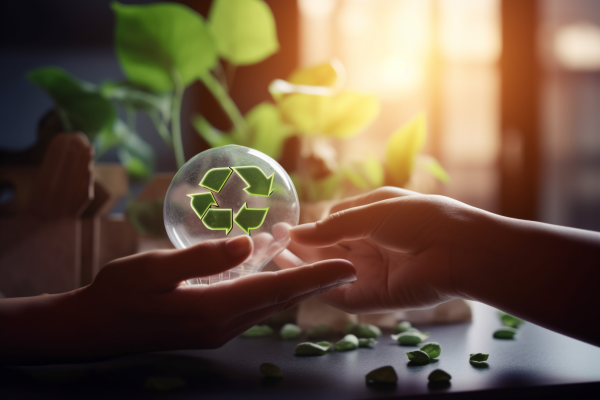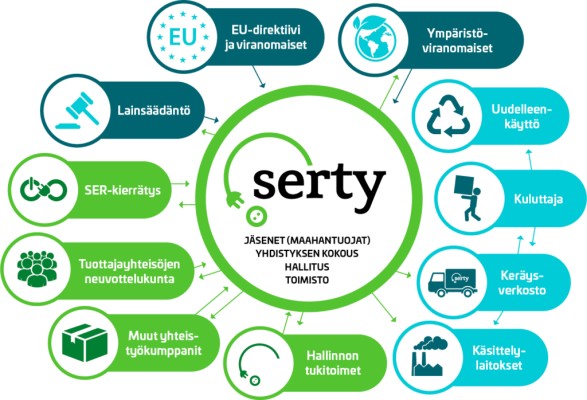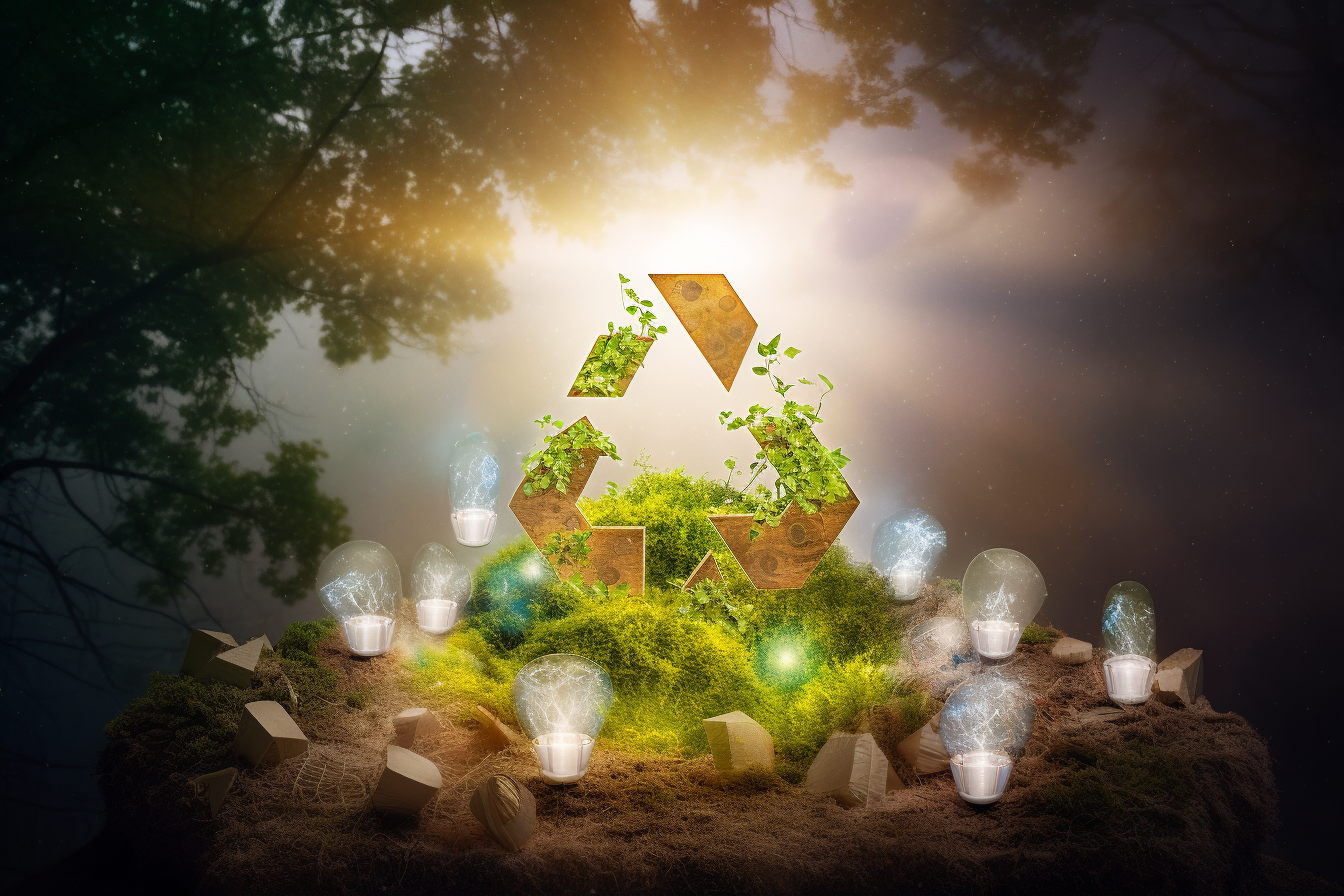This article discusses the importance and function of recycling LED lights, their recyclable materials and reprocessing options. It also looks at ways in which consumers can contribute to this process in their daily lives.
Led light recycling: how does it work?
LED lights have gained popularity thanks to their environmental friendliness and energy efficiency. They produce less heat and consume less energy than traditional light bulbs, making them a good choice for domestic and industrial use. However, LED lights also have an end-of-life and proper recycling is important for the environment and resources. Let’s start the article by going through some of the basics you should know about LED lights.
Environmental friendliness and energy efficiency of LED lights
LED lighting is an environmentally friendly and energy-efficient lighting solution that promotes sustainable development. LED lights are popular and efficient, and have several advantages over traditional incandescent bulbs, such as better energy efficiency, longer life and less environmental impact.
LED lights can help reduce electricity consumption and greenhouse gas emissions, as well as reduce waste and save natural resources. While LED lighting can be more expensive to purchase, their energy saving potential and longer lifetime make them a cost-effective investment in the long term. As LED technology advances and prices fall, the transition to more environmentally friendly lighting is easier and more affordable.
The importance of recycling LED lights
Proper disposal of lighting products is important for the environment, as it prevents the release of harmful substances into the environment and promotes the reuse of resources. The recycling of LED lights is particularly relevant due to their environmental friendliness and energy efficiency. Under recycling legislation, manufacturers are responsible for the entire life cycle of their electronic products, including the collection, transport and recycling of lights.
Innovative recycling technologies enable efficient recovery and reuse of LED light components. For example, metals such as aluminium and copper can be separated from LEDs by mechanical processes or hydrometallurgical methods. Electronic components, such as printed circuit boards, can also be recycled, for example through mechanical or chemical processing. Such technologies help not only to reduce overconsumption of natural resources, but also to minimise waste generation.
The importance of recycling LED lights is not limited to reducing environmental impact; it also offers economic benefits. Recycling used LED lights can save on the cost of raw material procurement and create new jobs in the recycling sector. In addition, companies operating in the recycling sector can also benefit from market growth and advanced technologies, which in turn contribute to circular economy objectives.
How LED light recycling works.
The next step is to look at the process of recycling LED lights in an environmentally friendly way that reuses resources. LED lights have an extended lifetime compared to conventional luminaires, which makes their recycling process different. Recycling starts with collecting the lamps and delivering them to a recycling plant for sorting.
Recycling facilities are a key element in the efficient recycling of LED lights. After sorting, the lamps are dismantled to separate the electronic components. The materials are then processed, allowing valuable substances to be recovered.
Copper, aluminium and rare earth metals are useful resources that can be used to make new LED lights or other electronic devices. In addition, the waste generated in the process can be used to produce energy by incineration in a waste-to-energy plant. Recycling LED lamps can save natural resources and reduce greenhouse gas emissions and environmental pollution.
Recyclable materials and reuse of LED lights
For the sustainability of lighting solutions, it is important to investigate which materials can be recycled in the LED lamp process and how they can be reused in different areas. LED luminaires use a wide range of materials, including aluminium, copper, silver, semiconductors and glass components. The reuse of these materials depends on their chemical composition and the effectiveness of recycling methods.
LED materials can be efficiently recycled through various methods, such as separating metals by mechanical or thermal means and processing them for the electronics industry, reusing semiconductors in the manufacturing process or for solar panels, and using glass components to make new glass or building materials. These methods can reduce the use of natural resources and reduce environmental impacts and waste.
The pursuit of sustainable lighting solutions also includes improving energy efficiency, long-life products and efficient reuse of materials in different sectors. More innovative recycling methods are expected in the future, which will further enhance the use of LED materials and help achieve more sustainable lighting solutions.

Methods of metal analysis
Recycling plants use a number of different methods to separate the different metals. Here is an overview of some of the most common methods:
- Magnetic separation: this is one of the simplest and most effective ways to separate ferromagnetic metals, such as iron and steel, from other metals. These metals are attracted by large magnets, while non-magnetic metals such as aluminium and copper move on.
- Eddy current technology: this technique uses electromagnetic fields to separate non-ferromagnetic metals such as aluminium, copper and brass. When these metals pass through an electromagnetic field, they create counter-currents (eddy currents) that eject them from the transport line.
- Density-based separation: in some cases, metals can be separated by their density. For example, lead is much denser than aluminium, so the two metals can be separated using a density-based separation technique.
- Spectroscopy: this is a more advanced technique, especially used in the recycling of electronic waste. It is based on the fact that different metals reflect and absorb light at different frequencies. A spectroscope can analyse this light and determine which metal it is.
- Sorting robots: some modern recycling plants use sorting robots that can identify and separate different metals. These robots often use machine learning and artificial intelligence to improve their accuracy and efficiency over time.
In practice, from Led luminaires you separate aluminium, which is used in Led luminaires for cooling, and other metals from the small electronics.
How you can contribute to the recycling of LED lights
Recycling LED lights is important for more sustainable lighting solutions and environmental protection. The first step is to choose durable, high-quality LED luminaires that will last longer and reduce waste. It is also important to recycle old LED lights properly so that their parts can be reused and harmful substances do not end up in the environment.
Choose durable, high-quality LED luminaires
Purchasing high-quality, durable lighting is beneficial in many ways. They offer long life and reduce waste. Sustainable manufacturers use high-quality, ecological materials and focus on energy efficiency. This quality is reflected in better colour rendering, more even light distribution and more efficient cooling management, which increases the life of the luminaire. Sustainable design also takes into account recyclability and the possibility to repair or upgrade the luminaire.
It is therefore worth investing a little more in higher quality LED luminaires initially, as this will pay off in terms of lower electricity and raw material consumption in the longer term. In environmental terms, this means resource efficiency and reduced emissions of CO2 from fossil fuel use. High-quality LED luminaires and a sustainable lighting strategy also support the principles of the circular economy, where the value of materials and resources is maximised and their lifetime is maximised. Thus, by purchasing high-quality LED lighting, consumers are contributing to energy efficiency, ecology and recycling.
Properly rotate disabled LED lights.
While it is important to choose durable, high-quality LED luminaires to prolong their life, at some point they will reach the end of their useful life. In this case, it is essential to know how to properly recycle the LED lights that are no longer in use. Recycling is not only environmentally friendly, it also helps curb excessive consumption of natural resources and energy waste.
Disposing of LED lights can be challenging due to the different materials they contain, such as glass, metal and plastic. In addition, the recycling process involves a number of other recycling challenges, such as transport and energy problems and resource constraints.
It is therefore important to familiarise yourself with local guidelines and practices for recycling LED light bulbs and taking old bulbs to collectors or collection points. In many cases, manufacturers offer return or recycling services for their LED products, making the role of the lamp owner easier in the process. Together, social responsibility and conscious action will ensure that the handling of LED lights is ecologically and ethically sustainable.
LedStore receives SER recyclable electronics.

You can also take the products yourself to a SORTTI station in the Helsinki region or to a recycling station in your own municipality.
Frequently asked questions
How long do LED lights usually last before they need to be recycled?
LED lights can last up to 25,000-50,000 hours before their efficiency deteriorates significantly. This means that they can be used for several years, depending on the daily use. However, when the power of an LED light drops to around 70% of its original output or stops working altogether, it is time to consider recycling it properly to protect the environment.
Is it more expensive to recycle LED lights than other types of lighting, such as fluorescent tubes or incandescent lamps?
The recycling costs and process for LED lights are different from other lighting fixtures such as fluorescent and incandescent lamps. The cost of recycling LED lights is at the same level or even lower due to better material recovery possibilities and fewer emissions of harmful substances into the environment.
Can LED lights be repaired or upgraded to extend their lifetime before recycling?
LED lights that resemble sunlight may lose their light output over time, but their life can be extended by repairing or upgrading them. Upgrading to LED modules offers many benefits, including energy saving potential and improved light output. In addition, replacing obsolete or faulty components with new and more efficient parts can help maintain the performance of the luminaire for longer. While repairing or upgrading LED lights can be challenging depending on the design or model of the luminaire, these measures can significantly increase their lifetime and contribute to sustainability by reducing electrical waste and curbing the consumption of natural resources.
Are all LED lights equally easy to recycle or are there some specific luminaire models or brands that can cause problems in the recycling process?
Reusing luminaires and recovering LED materials is important for the environment, but recycling all LED lights is not as easy. Different models and brands of luminaires may contain different components and materials that affect their recyclability. Some LED lights are designed to be easier to dismantle and repair, which promotes their reuse potential.
How do I ensure that LED recycling points are reliable and follow environmentally friendly practices?
In Finland, recycling is governed by legislation and consumers can take their electronic waste for recycling to any company that is part of the SER system. Local authorities or environmental organisations can provide lists of recommended recycling points for LED lights and guidance on how to handle them properly before disposal.
Conclusion
In summary, the LED recycling process is a key element in promoting environmental sustainability and resource efficiency. Efficient recycling methods can recover valuable materials from the disposal of LED lights, allowing them to be used in the manufacture of new products. Ultimately, promoting the circular economy of LEDs not only saves natural resources, but also reduces waste and greenhouse gas emissions. This is in line with the global trend towards sustainable development and highlights the importance of environmentally friendly practices, such as recycling LED lights, in our daily lives.
Specialist in Led lamps
LedStore has been an expert in led lighting since 2010. We have our own product design, so our products are technologically state-of-the-art.
We focus on light colour temperature controlled and high colour rendering index lights. We do around 500 lighting designs in a year.
We offer a service of custom made led strips, i.e. custom made led light strips in profile. Also installed.
Remember that we are always ready to offer our help to you along the way, by email (myynti@ledstore.fi) and by phone (045 251 4510). As always, feel free to share photos of your own projects on social media at ledstore.fi at Instagram and ledstore.fi at Meta. We love to see the cool things done by our LEDs, and it also helps to provide inspiration for those who are not sure about the power and awesomeness of LEDs. Did you know that we already have over 3500 pictures of our LED installations in our Gallery!
Gallery of Led lights:
Product gallery: Pictures of products in different installation locations
Indirect light: Indirect light in different spaces
Room-specific: Light in different rooms
References: Complete houses that have been photographed

